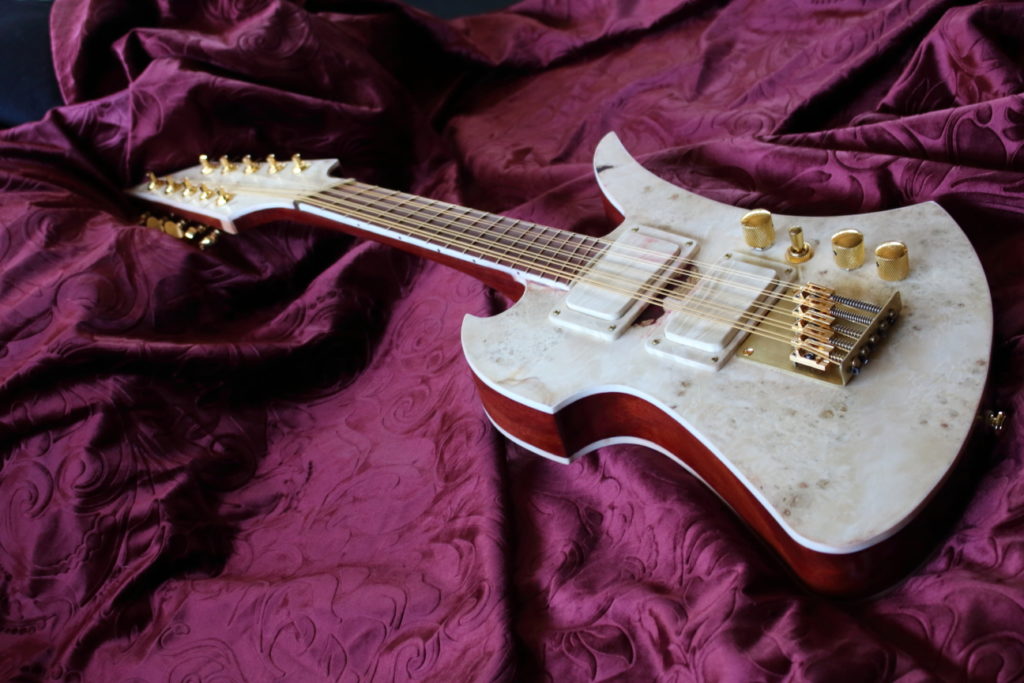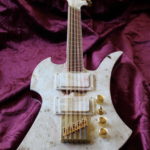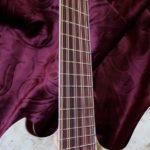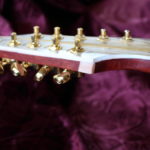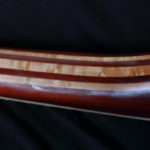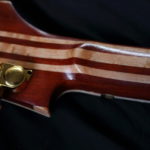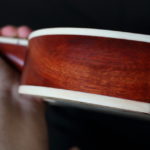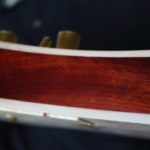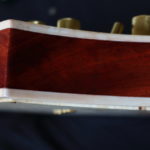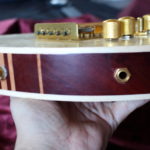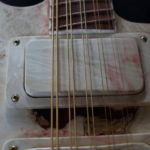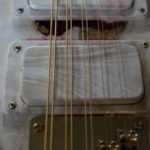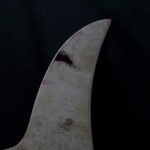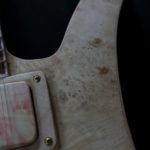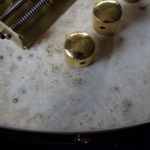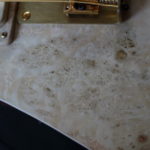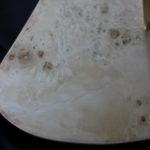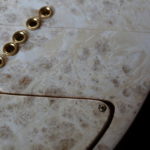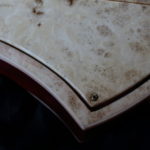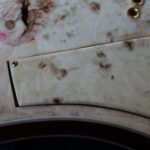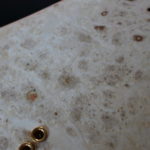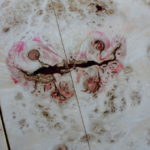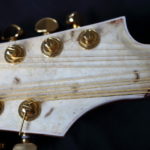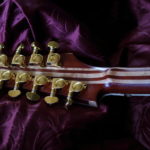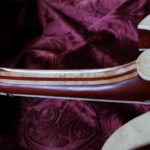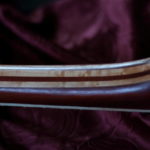The culmination of over a year of work, and close to fifteen years of research and designs.
The Bloodraven is a 10 string, fanned fret, through neck, solid body electric mandolin with a brass nut and wooden pickup rings and covers. The neck pickup is a Seymour Duncan ’59, and the bridge pickup is a Dimarzio X2N. It has a 3 way switch, a master volume knob, and a tone knob for each pickup.
The top, bottom, and headstock veneer are bleached box elder maple, and the body is bloodwood. The neck is laminated bird’s eye maple and bloodwood, with a bloodwood fretboard, with Jescar Evo Gold narrow fretwire. The headstock features Grover locking tuners and a brass nut I fabricated from scratch. I also fabricated the bridge plate myself and scavenged the saddles from a Gotoh 12 string bridge. The screws and springs I had to scour the internet for to get all the right sizes. The voids in the box elder are filled with dyed resin.
This project was the result of years of trying to figure out precisely what I wanted to get out of an electric mandolin, and then working out the logistics of actually putting it all together. After commissioning my first mandolin and deciding I was going to try to build one myself, I came up with a list of features I needed to design around.
- An extra course of strings to expand the range on the low end.
- 10 strings, because I feel like the double courses are an iconic part of what makes a mandolin different.
- Fanned frets to compensate for different scales at the low and high end of the fretboard, which allows less tension on the strings and improves playability.
- Dual humbuckers to be able to get big metally guitar sounds.
- Through neck construction and a brass nut to maximize the sustain, since being so short reduces sustain significantly.
- A way for the saddles of each string to be individually adjusted to keep proper intonation between pairs of strings.
Of those, the last one was the most difficult to work out. I spent years stuck trying to figure out the logistics of the bridge until I discovered that Gotoh made a bridge for 12 string guitars that came with saddles that can hold two strings and adjust for each string in the pair. This is what made the whole rest of it possible. It went through dozens of design iterations, originally starting as something closer to a traditional A-Style body shape, evolving over time into a sort of Iceman/Stealth combo, until I finally decided that a Mockingbird body fit best.
I’ve known for a long time I wanted to use bloodwood for the body, and I also knew I wanted to mimic the binding style on Brian May’s Red Special, where it has it on the front and back. I managed to get a hold of a big piece of 8/4 bloodwood lumber from Tropical Exotic Hardwoods and hung onto it for years. I was glad I did because it eventually became extremely difficult to get it in those dimensions afterward.
While working on a painting based on A Song of Ice and Fire it occurred to me how cool design wise a wierwood themed instrument would be, and so I had the final piece of the idea in place, I just needed to figure out a real world analog for wierwood. I stumbled upon several sets of book matched guitar top blanks of box elder maple on oregonburls.com and knew I could make it work. Some further research led me to believe I could bleach the box elder and keep all of the things that made it look interesting, including the stray bits of red. I bought extra just in case. If the instrument was going to be wierwood themed, it’d need an appropriate name, and Bloodraven just works so well. I used birds eye maple for the neck laminations as a reference to the character from the books. A thousand eyes, and all that.
When I got the pieces I realized I would need to come up with a solution for the knots and voids. Resin has been really popular among guitar builders lately, so there was plenty of information out there about how to use it to do what I needed.
I spent a couple months gathering the necessary tools and began to work on it at Pratt Fine Arts Center in February 2018. I worked intermittently on it, taking breaks when a problem arose to step back and get fresh eyes on it. It was around a year later when I first got strings onto it, then began to finish the wood with shellac and install the electronics. Around the end of May is when I could confidently say it was more or less finished. That said, it’s far from perfect. I made countless mistakes because it was my first time doing anything like this. There are spots where the finish could be touched up, and places I still need to scrape shellac from the binding. Some touch ups I need to do on the nut slots and leveling the 4th and 7th frets just a hair, but at the end of the day it works the way I designed it to.
I drew from a lot of sources in my research for how to do everything I needed to do to get this done, but a great deal of it I learned from Ben Crowe at Crimson Custom Guitars, Luke Graham‘s Multiscale build series, and Sully of Sully’s Guitars. I learned how to square lumber at Pratt from Steve Dando, and it was that little bit of knowledge that made woodworking make sense for me and the entire thing possible. Pratt is a great place and I can’t say enough good things about it and the people that make it what it is. I’ll be making another post soon about my build process and how I solved the problems I ran into.
